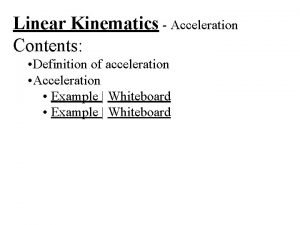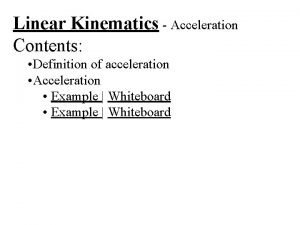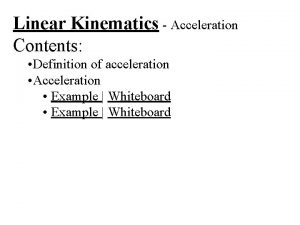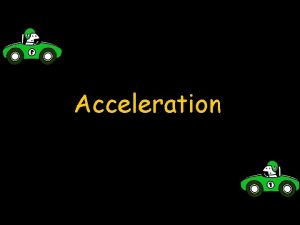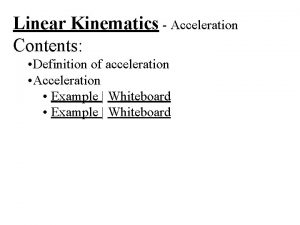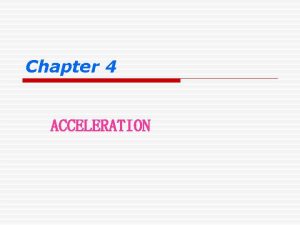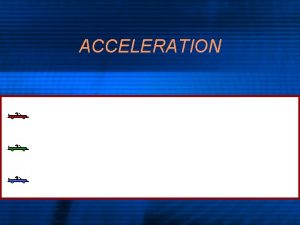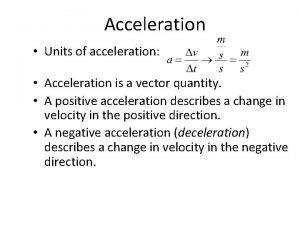Warm Up 1 What is the acceleration of








































- Slides: 40

Warm Up 1. What is the acceleration of an elevator at rest? 2. What is the net force when the elevator travels at a constant velocity? 3. When do most elevators accelerate during their motion? 4. When is the net force on the elevator not 0. 0 N?

Tension • Tension is a pulling force that arises when a rope, string, or other long thin material resists being pulled apart without stretching significantly. • When a cord, rope, chain, or cable is attached to a body and pulled tight, the cord, etc. , is said to be under tension. • The cord pulls on the body with a force T or FT, whose direction is away from the body and along the cord at the point of attachment.

• The cord is often considered to be massless (meaning the mass is small compared to the mass of the body) and unstretchable. The cord exists only as a connection between two bodies. • Tension always pulls away from a body attached to a rope or string and toward the center of the rope or string.

A Physical Picture of Tension Imagine tension to be the internal force preventing a rope or string from being pulled apart. Tension as such arises from the center of the rope or string. It creates an equal and opposite force on objects attached to opposite ends of the rope or string.

Tension • The cord pulls on the body at each end with the same magnitude T EVEN If…. • bodies and the cord are accelerating • cord runs around a massless, frictionless pulley Hand pulls cord to the right.

Tension • The frictionless pulley wheel changes the direction of the force only

Vertical Acceleration: Lifting an Object • Take the direction of the acceleration as positive (up +; down -). • Two forces present: Fg and T.

Vertical Acceleration: Lifting an Object • Example: determine the tension in the cord attached to a 5 kg mass when the upward acceleration is 2 m/s 2. • T = m·(g + a) = 5 kg·(9. 8 m/s 2 + 2 m/s 2) • T = 5 kg· 11. 8 m/s 2 = 59 N • For an upward acceleration, the tension T is greater than the weight Fg; T > Fg.

Vertical Acceleration: Lifting an Object • When an object moves upward at constant speed, a = 0 m/s 2, and the tension T will be equal to the weight Fg. • Example: determine the tension in the cord attached to a 5 kg mass when the mass moves upward at constant speed. T = m·(g + a) = 5 kg·(9. 8 m/s 2 + 0 m/s 2) T = 5 kg· 9. 8 m/s 2 = 49 N • The tension equals the weight Fw. Fg = m·g = 5 kg· 9. 8 m/s 2 = 49 N

Vertical Acceleration: Lowering an Object • Take the direction of the acceleration as positive (down +; up -). • Two forces present: Fw and T.

Vertical Acceleration: Lowering an Object • Example: determine the tension in the cord attached to a 5 kg mass when the downward acceleration is 2 m/s 2. • T = m·(g - a) = 5 kg·(9. 8 m/s 2 - 2 m/s 2) • T = 5 kg· 7. 8 m/s 2 = 39 N • For a downward acceleration, the weight Fg is greater than the tension T; Fg > T.

Vertical Acceleration: Lowering an Object • When an object moves downward at constant speed, a = 0 m/s 2, and the tension T will be equal to the weight Fg. • Example: determine the tension in the cord attached to a 5 kg mass when the mass moves downward at constant speed. T = m·(g - a) = 5 kg·(9. 8 m/s 2 - 0 m/s 2) T = 5 kg· 9. 8 m/s 2 = 49 N • The tension equals the weight Fw. Fg = m·g = 5 kg· 9. 8 m/s 2 = 49 N

Vertical Acceleration: Lowering an Object • Free fall would occur if the downward acceleration is 9. 8 m/s 2. T = m·(g – a) = 5 kg·(9. 8 m/s 2 – 9. 8 m/s 2) T = 5 kg· 0 m/s 2 = 0 N • T = 0 N means that there is no force in the cord at all! • So now, if a cable to the elevator broke and began to fall… what would the Net force be?

What are the forces at play on our bodies during the ride? • During the upward acceleration? Normal force exceeds weight, and the body feels heavy because the floor of the elevator is pushing us up harder than usual. • During constant velocity between floors? No net force on our bodies and the riders feel relatively normal. • During downward acceleration? Normal force is less than our weight, and the body feels light because the floor is not pushing us up as hard as it ordinarily does and there is less force on the soles of our feet.

Apparent Weight

Apparent Weight • If an object subject to gravity is not in free fall, then there must be a reaction force to act in opposition to gravity. • We sometimes refer to this reaction force as apparent weight.

Examples

Going Up? v=0 a=0 v>0 a>0 v>0 a=0 v>0 a<0 Heavy feeling Normal feeling Light feeling Wapp W W Ground floor Just starting up Between floors Arriving at top floor

Going Down? v<0 a<0 v=0 a=0 v<0 a>0 v<0 a=0 Heavy feeling Normal feeling Light feeling Wapp W W Top floor Beginning descent Between floors Arriving at Ground floor

Example: Weighing Yourself in an Elevator Suppose that your mass is 80 kg, and you are standing on a scale fastened to the floor of an elevator. The scale measures force and is calibrated in Newtons. Fn is what I referred to as tension T. (a) What does the scale read when the elevator is rising with acceleration a? (b) When it is descending with acceleration a’? (c) When it is rising at 20. 0 m/s and its speed is decreasing at 8. 0 m/s 2? January 27, 2011 Physics 114 A - Lecture 12 22/22




Pulleys Massless String Approximation Strings and ropes often pass over pulleys that change the direction of the tension. In principle, the friction and inertia in the pulley could modify the transmitted tension. Therefore, it is conventional to assume that such pulleys are massless and frictionless. January 27, 2011 Massless and Frictionless Pulley Approximation Physics 114 A - Lecture 12 26/22

Pulleys simply change the direction of the forces in the coordinate system. SF = m·a m 2·g = (m 1+m 2)·a Fn T m 1·g T m 1 m 2·g m 2

Simultaneous Horizontal & Vertical Accelerations; No Friction • The normal force exerted upward by the table is equal to and opposite in direction to Fw 1 and they cancel each other out; these forces are balanced.

Simultaneous Horizontal & Vertical Accelerations No Friction • Take the direction of the acceleration as positive. • Examine the forces acting on each mass separately. • The unbalanced force that accelerates the system is Fw 2.

Simultaneous Horizontal & Vertical Accelerations No Friction • For the mass on the table, m 1: –With no friction, the tension T in the cord is the only unbalanced force acting on m 1. –Take the direction of the acceleration as positive.

Simultaneous Horizontal & Vertical Accelerations No Friction • Because the two masses are connected by the same cord, as m 2 accelerates, so does m 1. • Examine the two equations:

Simultaneous Horizontal & Vertical Accelerations No Friction • Because the tension T in the cord is the same at both ends of the cord, the tension T in each equation is the same. Substitute T = m 1·a in to the m 2·g – T = m 2·a equation. • To determine the tension (2 options):

Simultaneous Horizontal & Vertical Accelerations No Friction • Example: if m 1 = 5 kg and m 2 = 6 kg, determine the acceleration of the system and the tension in the cord.

Atwood’s Machine T • A device for measuring the acceleration of gravity. • If m 1 and m 2 are nearly the same, slows down free fall such that acceleration can be measured. • Then g can be measured. m 2 m 1·g T m 2·g SF = m·a m 2·g - m 1·g = (m 2+m 1)·a

Atwood’s Machine • Take the direction of the acceleration as positive. • Examine each mass separately. • The tension T and the acceleration are the same for both masses because they are connected by the same cord.

Atwood’s Machine • For m 1: two forces are present, Fw 1 and T.

Atwood’s Machine • For m 2: two forces are present, Fw 2 and T.

Atwood’s Machine • Because the tension T is the same for both masses, set T=T and solve for the acceleration a:

Atwood’s Machine • Example: if m 1 = 2 kg and m 2 = 3 kg, determine the acceleration of the Atwood machine system and the tension T in the cord that connects the two masses.

Sharing Forces • When a single cord supports a stationary load, the single cord is responsible for supporting all of the weight of the load. • For a 10 kg mass supported by a single cord attached to the ceiling: T = Fw Fw = m·g = 10 kg· 9. 8 m/s 2 Fw = 98 N (downward), therefore, T = 98 N (upward)

Sharing Forces • When two cords support a stationary load by exerting an upward force only, the two cords are equally responsible for supporting all of the weight of the load. • For a 10 kg mass supported by two cords attached to the ceiling: T = Fw Fw = m·g = 10 kg· 9. 8 m/s 2 Fw = 98 N (downward) • Each cord supports one-half of the weight of the load: • T 1 = 49 N and T 2 = 49 N

Sharing Forces • When four cords support a stationary load by exerting an upward force only, the four cords are equally responsible for supporting all of the weight of the load. • For a 10 kg mass supported by two cords attached to the ceiling: T = Fw Fw = m·g = 10 kg· 9. 8 m/s 2 Fw = 98 N (downward) • Each cord supports one-fourth of the weight of the load: • T 1 = 24. 5 N, T 2 = 24. 5 N, T 3 = 24. 5 N, and T 4 = 24. 5 N
 Radial acceleration formula
Radial acceleration formula Kinetic angular energy
Kinetic angular energy Radius eclipse wine
Radius eclipse wine Tangential acceleration and centripetal acceleration
Tangential acceleration and centripetal acceleration Angular acceleration vs linear acceleration
Angular acceleration vs linear acceleration Tư thế ngồi viết
Tư thế ngồi viết Kể tên các môn thể thao
Kể tên các môn thể thao Hát kết hợp bộ gõ cơ thể
Hát kết hợp bộ gõ cơ thể Cái miệng nó xinh thế
Cái miệng nó xinh thế Cách giải mật thư tọa độ
Cách giải mật thư tọa độ Tư thế ngồi viết
Tư thế ngồi viết Thế nào là giọng cùng tên? *
Thế nào là giọng cùng tên? * Gấu đi như thế nào
Gấu đi như thế nào Thẻ vin
Thẻ vin Thơ thất ngôn tứ tuyệt đường luật
Thơ thất ngôn tứ tuyệt đường luật Khi nào hổ mẹ dạy hổ con săn mồi
Khi nào hổ mẹ dạy hổ con săn mồi Từ ngữ thể hiện lòng nhân hậu
Từ ngữ thể hiện lòng nhân hậu Thế nào là hệ số cao nhất
Thế nào là hệ số cao nhất Diễn thế sinh thái là
Diễn thế sinh thái là Slidetodoc
Slidetodoc Vẽ hình chiếu vuông góc của vật thể sau
Vẽ hình chiếu vuông góc của vật thể sau Làm thế nào để 102-1=99
Làm thế nào để 102-1=99 Lời thề hippocrates
Lời thề hippocrates Vẽ hình chiếu đứng bằng cạnh của vật thể
Vẽ hình chiếu đứng bằng cạnh của vật thể Chụp tư thế worms-breton
Chụp tư thế worms-breton đại từ thay thế
đại từ thay thế Quá trình desamine hóa có thể tạo ra
Quá trình desamine hóa có thể tạo ra Công thức tiính động năng
Công thức tiính động năng Khi nào hổ mẹ dạy hổ con săn mồi
Khi nào hổ mẹ dạy hổ con săn mồi Thế nào là mạng điện lắp đặt kiểu nổi
Thế nào là mạng điện lắp đặt kiểu nổi Các châu lục và đại dương trên thế giới
Các châu lục và đại dương trên thế giới Các loại đột biến cấu trúc nhiễm sắc thể
Các loại đột biến cấu trúc nhiễm sắc thể Bổ thể
Bổ thể Nguyên nhân của sự mỏi cơ sinh 8
Nguyên nhân của sự mỏi cơ sinh 8 Phản ứng thế ankan
Phản ứng thế ankan Thiếu nhi thế giới liên hoan
Thiếu nhi thế giới liên hoan Hát lên người ơi alleluia
Hát lên người ơi alleluia điện thế nghỉ
điện thế nghỉ Một số thể thơ truyền thống
Một số thể thơ truyền thống Trời xanh đây là của chúng ta thể thơ
Trời xanh đây là của chúng ta thể thơ Hệ hô hấp
Hệ hô hấp














































